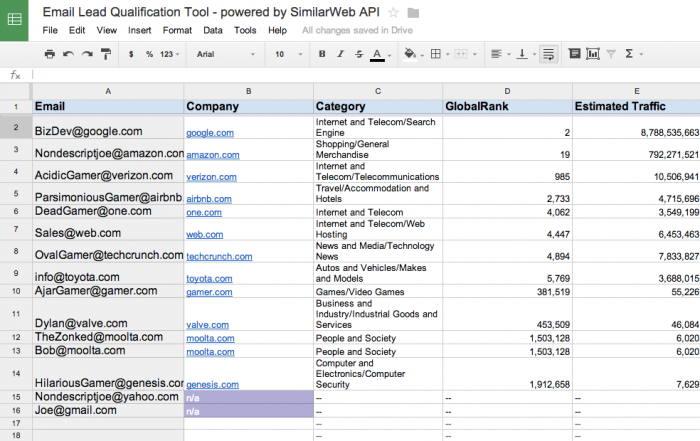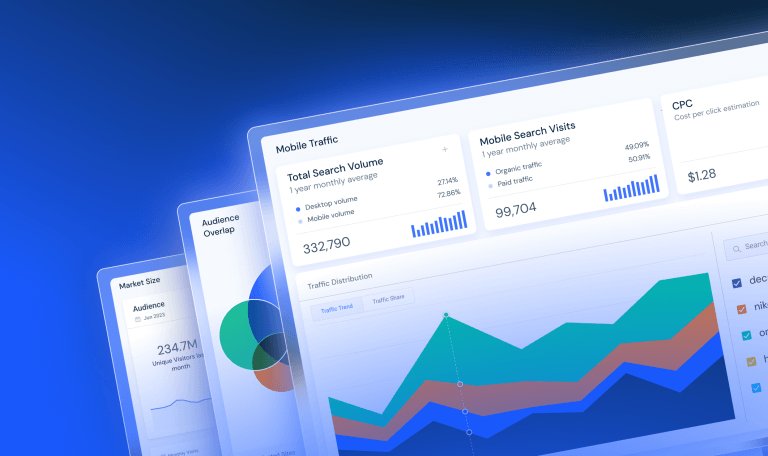3 Benefits of Using the Similarweb API to Automate Better Lead Scoring

Connecting sales with leads is the heart of any business, but finding and qualifying leads is messy. Marketing campaigns, no matter which channel is being utilized, by nature are designed to bring in large amounts of leads. Delivering too many leads to a salesperson can be just as harmful as under delivering leads, especially if the leads are irrelevant.
It’s relatively easy to collect names and email addresses for people who have shown, or ought to show, some interest in your business. You may have a newsletter subscription box, you may spend lots of time in a CRM tool, or you may be really good at finding relevant contact information around the web.
But when facing a high volume of leads you need to make sure that your sales team knows which leads are the most important so that they can invest their time in the most effective fashion.
How explicit and implicit lead scoring helps
One study from RainToday.com found that less than 25% of all new leads are actually ready to receive a pitch. This means that the other 75% will require different engagement strategies to build the relationship until the leads have been nurtured enough to get pitched. Lead scoring, a method in which each prospect is graded according to where he is in the sales funnel, allows companies to market more efficiently and effectively. Cold prospects can be ignored, warm ones can be nurtured and almost-buyers can be gently pushed towards closing.
Lead scoring is based on both explicit and implicit scoring. Explicit scoring is based on information provided to you by the prospect and other direct information, such as demographics, industry, job title and company size. Implicit scoring is what can be inferred about the lead, based on online behavior.
Collecting explicit information can be prohibitively time-consuming. That’s where the Similarweb API’s Email Lead Qualification Tool comes in handy. When you use this handy and easy tool, the Similarweb API allows you to enter email addresses of prospects and pull explicit information automatically – including company category, global rank and estimated traffic.
All the data is uploaded into a Google Spreadsheet, where it can be easily sorted for efficient lead scoring. You can upload your contacts on separate sheets, to separate prospects from different marketing avenues, such as newsletter subscribers, former customers, tool users etc.
Decide which metrics are the most important to your company, and then add new columns for lead score and give each contact a grade. For a step-by-step guide on how to score your leads, we recommend referencing Act-On’s “Introduction to Integrated Marketing: Lead Scoring.”
Key benefits of lead scoring with the Similarweb API
Czech software company Kentico asked website owners who use lead scoring how this powerful practice had changed the game for them, with eye-opening results.
In this context, integrating your organization’s lead scoring activities with the Similarweb API gives you access to the following key benefits.
1. Increase results
It makes sense that just 10% improvement in lead quality scores results in a 40% increase in sales effectiveness. About 42% of those polled by Kentico named measurable ROI on their lead generation program as a main benefit, while 38% named increased conversion rates.
Armed with the Similarweb API’s data on your prospects’ company category, global rank, and estimated traffic, you’ll have valuable intelligence regarding prospects’ relevance, all in one integrated and sortable spreadsheet view.
2. Allow representatives to focus on the best marketing leads and shelve the unqualified ones
Nearly one-third of the people surveyed in the Kentico study said that increased efficiency was the greatest benefit.
Focusing on the right accounts and the right contacts within those accounts can save both marketing and sales teams a lot of time. And using the Similarweb API to pull relevant data into a spreadsheet allows you to build automated formulas that reveal the “lowest hanging fruit.”
3. Create a common lead definition across all marketing and sales platforms and strategies
19% cited increased alignment of marketing and sales efforts as the top benefit of lead scoring. Common definitions and rules for when a prospect is passed from marketing over to sales, increases efficiency and makes for smoother processes.
With the Similarweb API, you can segment leads according to department and use a unified method to score every row.
Check it out
To get started now with the Email Lead Qualification Tool on a trial basis for free, register for your temporary API key, and then follow the simple instructions on the resource page.
Wondering what Similarweb can do for you?
Here are two ways you can get started with Similarweb today!





